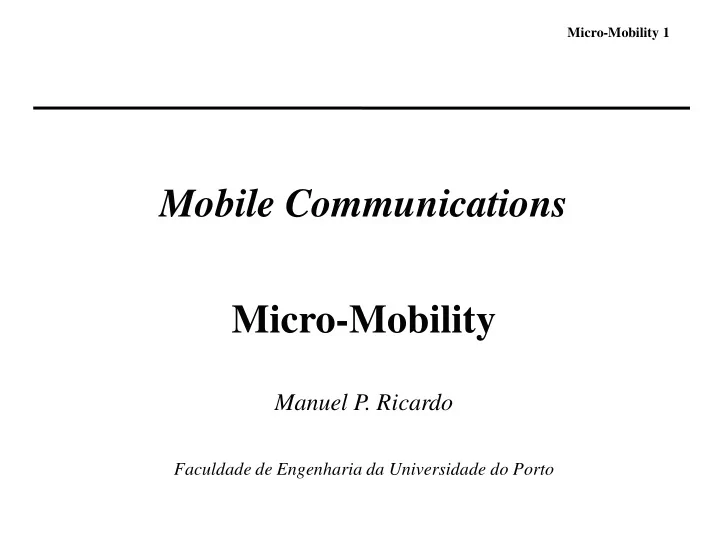

Micro-Mobility 1 Mobile Communications Micro-Mobility Manuel P. Ricardo Faculdade de Engenharia da Universidade do Porto
Micro-Mobility 2 Mobility in IEEE 802.11
Micro-Mobility 3 ♦ How is mobility currently managed in IEEE 802.11 networks?
Micro-Mobility 4 Break and Make ♦ Two concepts for roaming » Break before make – station ends association with current AP before creating an association to a new AP » Make before break – station associates with new AP before disassociating from the old AP ♦ Normal roaming in 802.11 break before make » simpler MAC, simpler radio » but ... data is lost during roaming
Micro-Mobility 5 Layer 2 vs Layer 3 Roaming
Micro-Mobility 6 IEEE 802.11 Roaming ♦ Sequence of events 1. Station decides when to roam based on signal strength, frame acknowledgment, missed beacons, … 2. Station decides where to roam (new AP) scans the medium for new APs, either before or after the decision to roam 3. Station initiates the roam sends reassociation frames to associate to a new AP 4. Station resumes existing data transferences ♦ Roaming duration depends on some processes » probing » 802.11 authentication » 802.11 association » 802.1X (security, keys)
Micro-Mobility 7 AP Discovery ♦ Active scanning » station actively searches for an AP » station – sends probe requests and waits for probe responses from AP, on each channel – probe response delay in a channel: 10 to 20 ms ♦ Passive scanning » station silently listens for beacon frames on each channel » station continues to change channels » slower then active scanning; AP sends usually 10 beacon/s
Micro-Mobility 8 Configuring Routes During L2 Roaming (./…)
Micro-Mobility 9 Configuring Routes During L2 Roaming (../…)
Micro-Mobility 10 Configuring Routes During L2 Roaming (…/…)
Micro-Mobility 11 IEEE 802.11 Roaming - Problems ♦ (Re)Authentication process may take hundreds of ms » Particularly when 802.1x is used (individual encryption keys) ♦ Unacceptable for VoIP ♦ New standard under development » 802.11r » Keys and QoS reservation transferred between APs
Micro-Mobility 12 Micro-Mobility IP FEUP MPR
Micro-Mobility 13 ♦ How can micro-mobility be handled at the IP layer?
Micro-Mobility 14 Micro-mobility solved at the IP Layer ♦ Micro-mobility Frequent movements in an IP domain ♦ Problems of using Mobile IPv6 in micro-mobility scenarios » Time required to detect the new network » Time required for the terminal to configure an address in the new network » Time required to update the new location (BindingUpdate) near the HomeAgent » Packets sent to old CoA are lost » Frequent movement lots of signalling ♦ Solutions » First - IP Celular, HAWAII » More recently - FastHandover, HMIP - Hierarchical Mobile IP, Context transfer ♦ But, and whenever possible, » Micro-mobility better performed at layer 2 ….
Micro-Mobility 15 Handover in MIP Decision to handover Establishment of new link(layer 2) MN forms new CoA; BindingUpdate is sent to HA MN may start Tx from new location BU received MN starts Rx packets in new location time
Micro-Mobility 16 FastHandover Solution » MN learns about new router while connected to current router – Make before break – Fast detection of the NewAccess Router (NAR) – Auto-configuration of new CoA is antecipated » MN also receives packets send to the PreviousAccessRouter – While BindingUpdate is not finished Previous Access Router MN (PAR) CN Internet New Access MN Router (NAR)
MN PAR NAR Micro-Mobility 17 | | | FastHandover – |------RtSolPr------->| | |<-----PrRtAdv--------| | Previsible Handover | | | |------FBU----------->|--------HI------->| | |<------HAck-------| | <--FBack---|--FBack---> | | | | disconnect forward | | packets=============>| | | | | | | » MN discovers New Access Router connect | | | | | – Using layer 2 mechanisms |--------- FNA ------------------------->| – E.g. by scanning WLANs |<=========================== deliver packets | | » MN forms NCoA – RouterSolicitationforProxyAdvertisment (RtSolPr) – ProxyRouterAdvertisment (PrRtAdv) » MN requests tunnel establishment between PCoA e NCoA – FastBindingUpdate (FBU) » MN sends FastNeighborAdvertism (FNA) to inform NAR about its arrival – NAR starts delivering packets to MN
MN PAR NAR Micro-Mobility 18 FastHandover – | | | |------RtSolPr------->| | |<-----PrRtAdv--------| | Reactive Handover | | | disconnect | | | | | | | | connect | | |------FNA[FBU]-------|---------------->| | |<-----FBU--------| | |------FBack----->| | forward | | packets============>| | | | | | deliver |<==================================packets | | ♦ FBU sent from new location/link » In a single message, MN announces itself to NAR and requests tunnel » NAR contacts PAR sends FastBindUpdate
Micro-Mobility 19 Hierarchical Mobile IPv6 (HMIPv6) ♦ Operation » Domain has Mobility Anchor Point MAP – Regional COA (RCOA) is mapped to Link COA (LCOA) Internet » In handover, MN just informs MAP HA – Gets new LCOA, but maintains RCOA RCOA » HA is contacted only when MAP changes MAP binding update AR AR LCOA old LCOA new MN MN
Recommend
More recommend